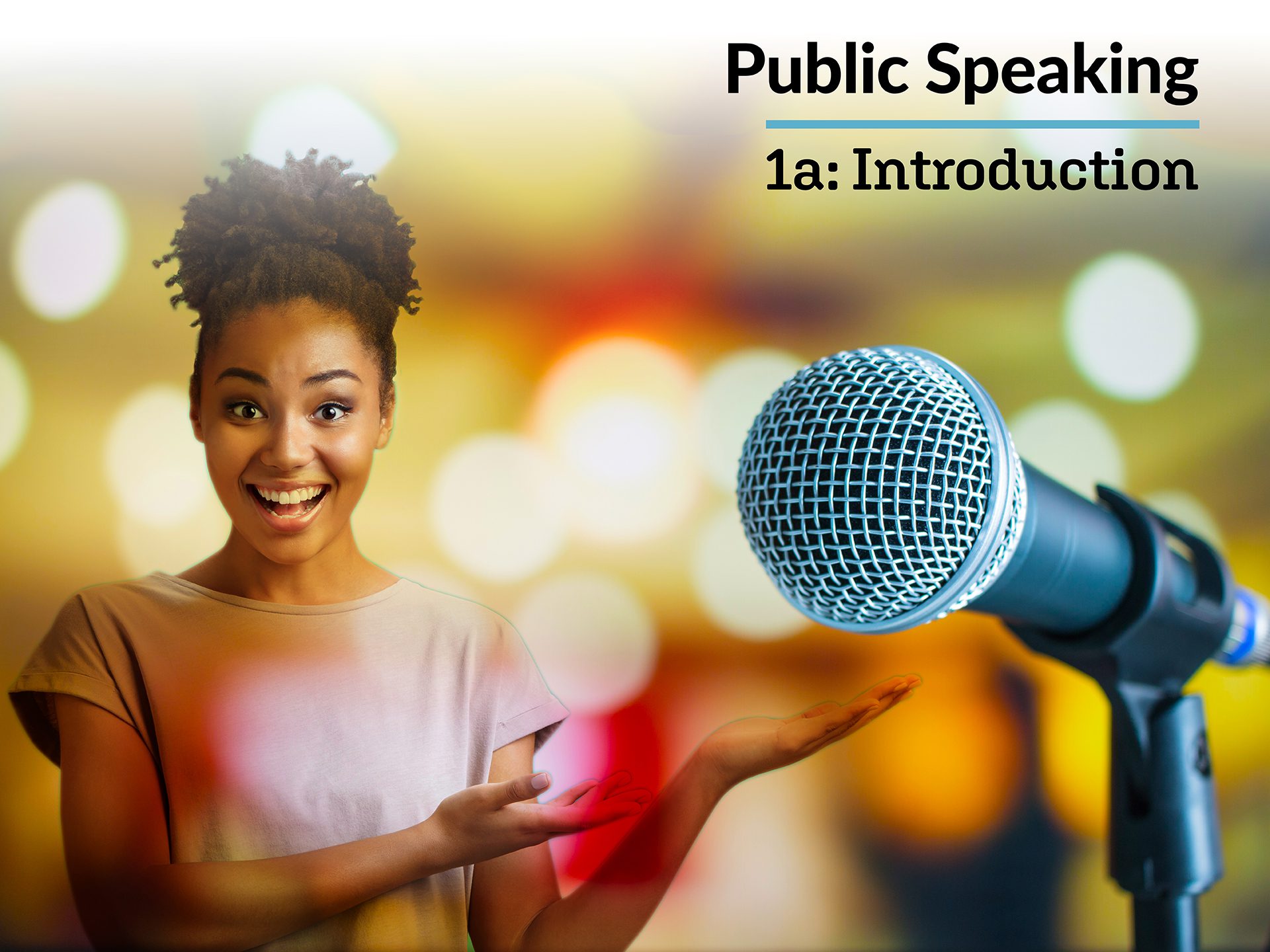
Public Speaking 1a: Introduction
Step up, speak out, and own the spotlight—wherever it may be! This course will give you the tools and confidence to tackle any speaking situation, from classroom discussions to national broadcasts. You’ll discover how to select powerful topics, tune in to your audience, and deliver speeches that make an impact while overcoming the fear that holds so many back. Thanks to practical and easy-to-use strategies, you’ll develop a voice that’s not just heard, but remembered. Whether you’re dreaming of a future in the media or just want to speak up with confidence, this course is your launchpad to success!
Units at a Glance
Unit 1: The Art of Public Speaking
What are you afraid of? Spiders? Heights? Flying? Even the bravest among us are afraid of something. As it turns out, the number one fear for most people is the fear of public speaking. But here’s the good news: You don’t have to be afraid! Despite what you may think, you are already a pretty good public speaker—you need to give yourself credit for the many times a day you share your thoughts, opinions, and ideas with more than one other person at a time. In this unit, you’ll look at ways to build on the skills you already have and develop strategies to address the areas that need extra attention. You’ll also learn about several famous people who conquered their fear of speaking in front of a crowd.
What will you learn in this unit?
- Identify both formal and informal situations that require public speaking
- Articulate strategies to overcome the fear of public speaking
- Demonstrate how preparation and practice improve a person’s public speaking skills
- Evaluate the qualities that inhibit or support good public speaking skills
Unit 2: What’s the Big Idea?
Recall the last good speech you heard and think about what made it memorable. Perhaps it was given for a special occasion or by a dynamic speaker. Maybe it was just a timely distraction from your daily routine. You probably found the topic engaging, and that’s why you remember the speech. While it may not sound difficult to choose a topic to talk about, a lot of speakers find it challenging. They want to make sure they reach their audience in ways that leave a lasting impression. After all, if they go to the trouble of preparing and delivering a speech, they believe what they have to say has significance. In this unit, we’ll identify strategies to help you choose good public speaking topics that are designed for both the occasion and your audience.
What will you learn in this unit?
- Evaluate what makes a speech topic interesting, meaningful, and timely
- Implement strategies to choose a speech topic
- Assess whether the audience is receiving the message as it is intended
- Identify characteristics of inspirational speeches
- Recognize how factors such as venue and speech length influence how an audience receives information
Unit 3: Finding Your Purpose
You’ve chosen a topic—so, now what? Identifying something to talk about barely grazes the surface of what public speaking is all about. When you address a group of people, you want to demonstrate that you do so with intention—that your words are intended to be received with a certain understanding. Public speaking, whether it’s done standing on a stage in front of hundreds of people or sitting at the dinner table with your immediate family, raises questions like “Why am I the one talking?” and “What do I want my audience to know when I’m finished?” That’s where purpose comes into play. A good public speaker knows what they want from their interaction with the audience. Identifying your purpose before you craft a speech can make the difference between being an adequate public speaker and a great one.
What will you learn in this unit?
- List common types of speeches by the purposes they serve
- Recognize the qualities of informative and entertaining speeches
- Identify the types of speeches used in academic and workplace settings
- Explain how speakers motivate and persuade their audiences
- Implement strategies to respond to impromptu requests to speak publicly
Unit 4: The Power of Persuasion
So far, you’ve learned about choosing a meaningful topic, the purposes and occasions for various types of speeches, and why matching the tone to the goal of your speech helps you reach your audience more effectively. It’s time now to delve deeper into one particular type of speech: the persuasive speech. This form of public speaking requires comprehensive research, considered reasoning, and careful organization. Don’t worry, though—we’ll work through the process step by step.
What will you learn in this unit?
- Identify situations and careers in which persuasive speaking is used
- Recognize rhetorical appeals by their characteristics and uses
- Describe the differences between inductive reasoning and deductive reasoning
- Explain how propositions of fact, value, and policy are employed to persuade an audience
- Understand the importance of rebutting counterarguments when giving a persuasive speech
Unit 5: Research Strategies
Pat yourself on the back—you are well on your way to crafting a fabulous persuasive speech. You have great ideas for a topic, your purpose is clear, and you’ve given thought to the strategy you want to use. But remember that all these elements mean nothing if you don’t have support for your position and the evidence to back it up. You may have your audience nodding in agreement for a little while, but in the end, are they really persuaded? Let’s make sure they are.
What will you learn in this unit?
- Assess a claim’s merit and the evidence supporting that claim
- Evaluate the best type of evidence to support an argument
- Prepare an interview and gather evidence
- Incorporate data and statistical evidence
- Cite sources to include in a persuasive speech
Unit 6: Learning From the Best
You may be new to public speaking, but public speaking is not new. Its purposes have changed over the centuries, and the forms it follows and tools used by speakers have been honed, studied, and improved upon. As public speakers, we are standing on the shoulders of some of the greatest minds and voices in history. Let’s get to know some of them.
What will you learn in this unit?
- Identify how rhetorical canons were used to teach public speaking skills
- Recognize how classical rhetoric has influenced Western thought
- Analyze the use of persuasive speech to influence public policy and social thought
- Evaluate the impact of TED Talks on public speaking
Unit 7: Assessing Your Audience
In public speaking, you are the sender, your speech is the message, and your audience members are the receivers. When you’re working on your message, keep the receivers in mind. The content of your speech is your foundation, but knowing your audience will guide you in terms of writing and delivering the speech. The whole point is to engage the listeners, after all—to persuade them, to entertain them, or maybe to inspire them to take action. So, it makes good sense to get to know them. Let’s find out how!
What will you learn in this unit?
- Recognize the importance of learning about your audience before giving a speech
- List techniques speakers use to engage their audiences
- Explain how to use empathy when speaking to an audience
- Identify the characteristics of an engaged audience
- Discuss strategies for being considerate toward the audience
Unit 8: Ethics in Public Speaking
From an early age, we’re taught the difference between right and wrong. We’re told that we should not hurt others, tell lies, or take things that don’t belong to us. Sometimes we can’t do things because it’s unethical to do so. Other times, it’s illegal to do certain things. The world of public speaking intersects with ethical norms and legal rules all the time. Knowing what we can and cannot say as well as what we should and should not say when we give speeches is all part of the process of creating ethical content.
What will you learn in this unit?
- Identify types of speech that are not protected under the First Amendment
- Explain how spreading false information poses a danger to audiences
- Demonstrate how to handle evidence that contradicts an argument
- Recognize the pros and cons of using artificial intelligence as a tool in public speaking
- Understand the seriousness of plagiarism
Required Materials
Physical
- Video recording device
Software
- Word processing software
Other
- Helper
Optional
- Art supplies
- Audio recording device
- Graphic design software
- Poster board
- Presentation software
- Spreadsheet software
- Video recording device



